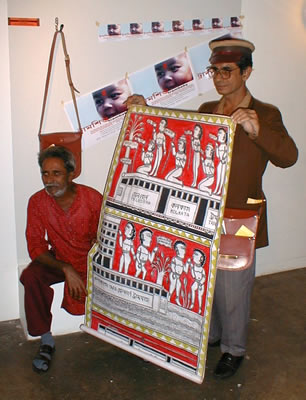Tramjatra
Melbourne’s sacred cows come home

The end of the 20th century seemed like an epochal garage sale. Public
assets were sold off to clear the way for smart outfits from the northern
hemisphere. Telecom, Gas & Fuel, SEC, home grounds and local banks—all
needed to make way for the global order of the third millennium. Yet
barely two years into the 21st century, things are not going according
to plan.
The world is currently focused on the dramatic glitch of September 11, which has put a brake on global movement. But there are some positive deviations from plan also. A few local favourites thought lost forever are now returning home. Rather than disappear entirely, it turns out they have merely been in exile. In September, the Roy Boys returned from Brisbane to win premiership glory in Melbourne. And in November, the friendly culture of tram conductors that seemed lost to privatisation now returns via Calcutta.
The Tramjatra festival is part of an ongoing exchange between Melbourne and Calcutta, based on their shared tram heritage. In 2000, Moomba featured a Calcutta-inspired tram, which deified the tram conductor in the image of Durga, the ten-armed Hindu goddess widely celebrated in Bengal. Melbourne’s tram hero Roberto D’Andrea has been back and forth between India and Australia forging a cross-cultural commitment to trams—not just as a practical means of transport, but as a way of life. The Bengalis gave him the honorary title ‘Pagla’, which means ‘holy fool’—we might call him a ‘Malcolm’.
D’Andrea led a small army of tram diplomats. Melbourne writer Suzie Attiwill provided the Calcutta Statesman newspaper with a regular column on tram affairs. And industrial design lecturer Michael Douglas found the Indo-Australian romance a legitimate institutional home in RMIT.
Tramjatra binds together two cities at opposite ends of the socio-economic table. And that’s what trams do. They bring people together. Unlike trains, trams wait for passengers, they respond to their wishes. Passengers are not divided by carriages.
In cool Melbourne, trams serve up a warm, comic version of real life. We can view works of art on trams, eat on tram restaurants, watch plays staged on trams and read tram poetry. They turn a group of individuals into fellow travellers, a bunch of strangers into an audience.
Now trams are moving Melbourne into the new century—not the techno-utopia conjured by digital evangelists, but a slow recovery of our democratic cultures. Trams usurped the position of Moomba Monarch and are now the key element in the annual people’s festival. In the magical Trams on Parade, their carriages form moving stages for colourful morality plays on issues ranging from vegetarianism to Koori mythology. And in a victory off-stage, Preston Tram Depot, which had slipped through the privatisation dragnet, has been granted a reprieve: the local knowledge necessary for the long-term survival of W Class trams can now be secured.
The Tramjatra chapter of tram history suggests a less likely link between Melbourne and India. In its reverence for trams, Melbourne exhibits the Indian attitude to sacred cows. In a typical Melbourne scene, a tram appears around a corner, trundling down the middle of the road, its bell ringing rhythmically, cars and people scurrying out of its path. They are large, cumbersome beings exempt from the normal ledger of consumption. In May this year, the W Class tram miraculously defied economic rationality and resumed its free service encircling the city. And like the cows in India, Melbourne trams are gaily adorned for special occasions.
As well as spicing up our public culture, Tramjatra also renews the cultural journey to India. For seekers of the 60s, India was a destination for spiritual enlightenment. Today, the children of those pilgrims are retracing the steps of their parents, and finding in India new language of local identity.
Things have been less cosy in the everyday life of Melbourne’s working trams. Since ticket machines replaced conductors in 1998, everyday trams have become lonelier places. The new custodians of tram culture began with hectoring announcements over the PA, full body-wrap advertising on the tram exterior that cast passengers into gloom, and a validation campaign fought by mercenary comedians.
The current plan is to put trams into the fast lane of techno-chic. Swanston Trams has abstracted its name to ‘M>’. Future plans include SuperStops, featuring ‘Smart Guides’ designed by Pixeltech.
But apart from fiddled brakes, the W Class trams trundle along just as they have for generations. They are like the tiny population of endangered frogs that forces the redirection of a freeway.
Progress needs these obstacles. With any development, there will be winners and losers. Left unhindered, such progress will spark resentment and division within the community. Sacred cows offer a solution: privileging the interests of the weakest members of the community serves to cap individual resentments. What seemed left behind in the past now becomes a mascot for the future.
As the 21st century lurches on, there may be a way to avoid deadlocking our hearts against strangers. The diaspora of sentiment that seemed a product of the millennial changeover has provided us with outposts of hope in unlikely places. Like the countries of the soviet bloc in the 1990s, we wait for the exiles to return home. Tram global, feel local.
Kevin Murray©2000